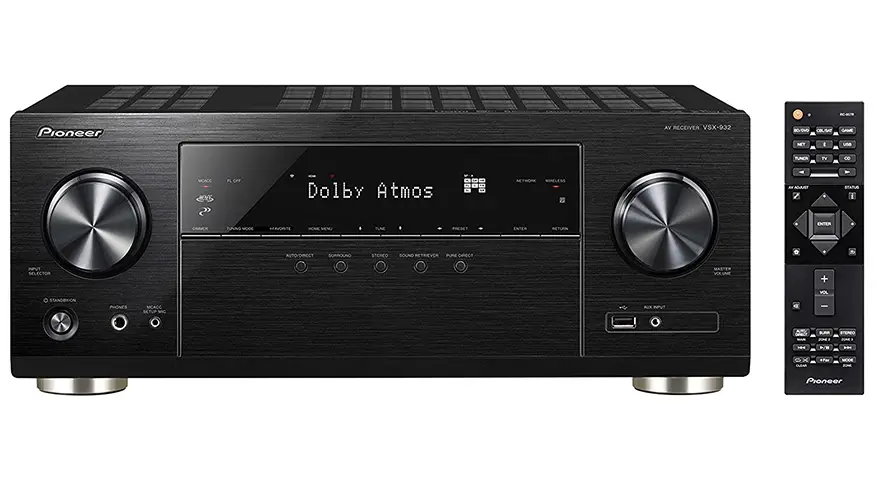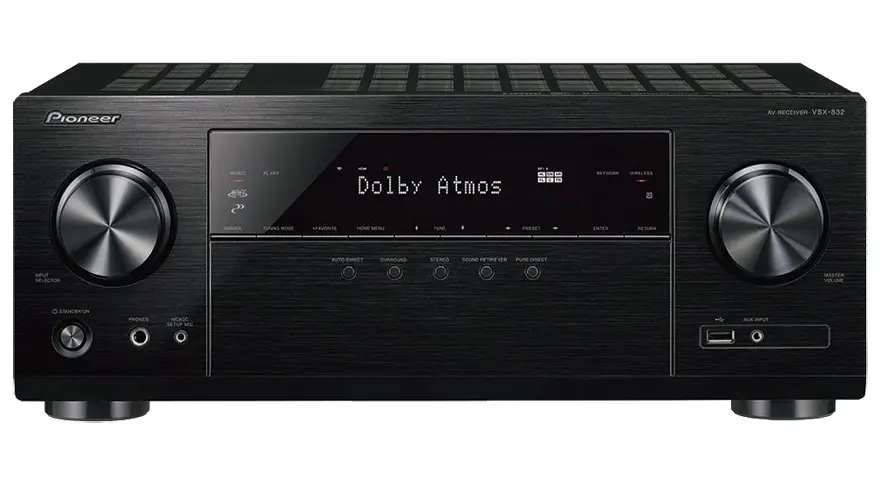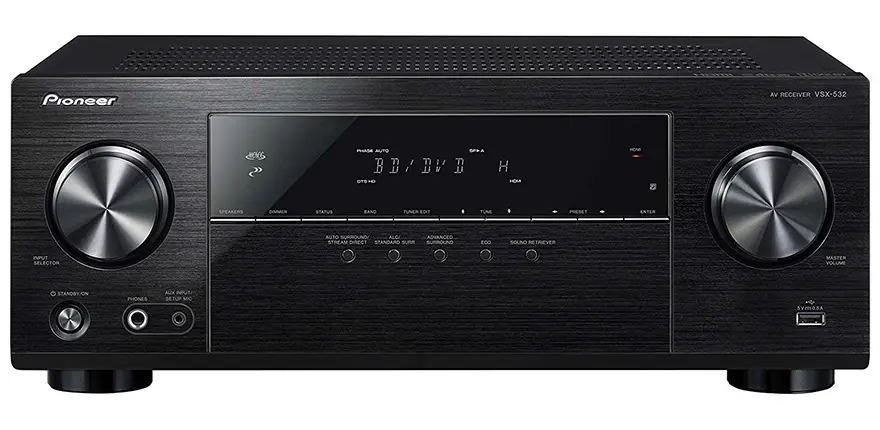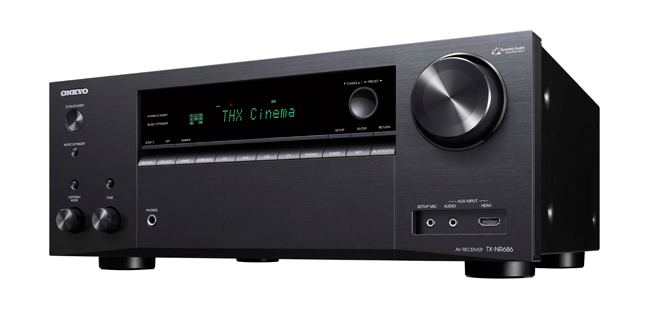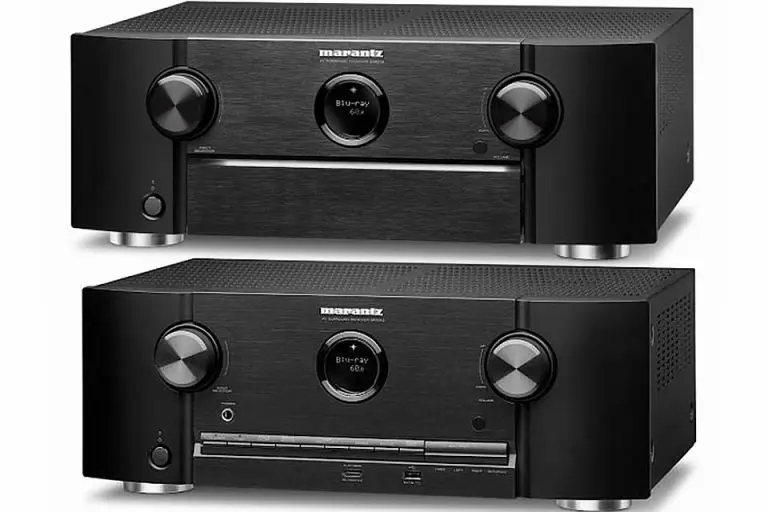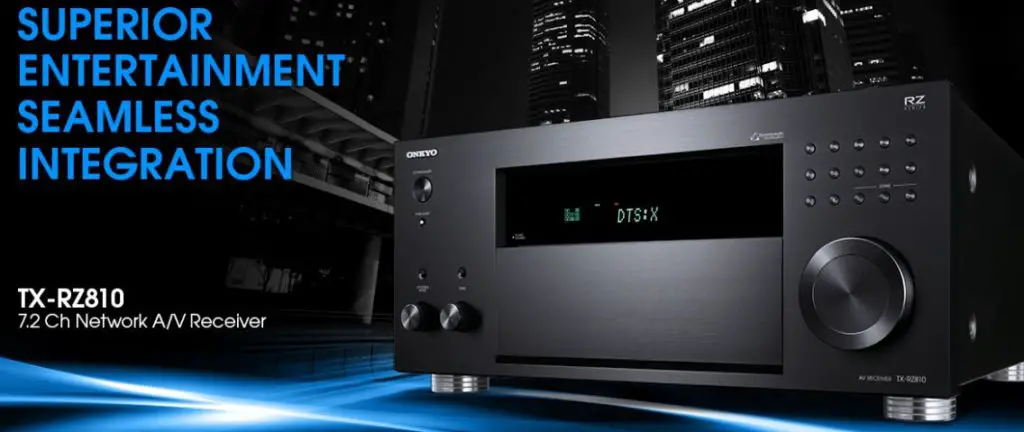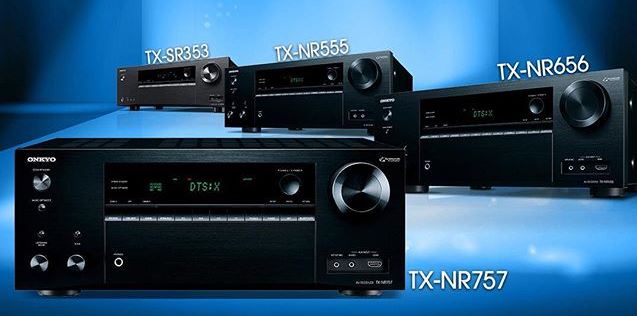Are you ready to elevate your home theater experience? The world of audio-visual receivers is constantly evolving, and 2025 brings an exciting lineup that promises to deliver immersive sound and stunning visuals.
With so many options available, it might feel overwhelming to choose the perfect one for your setup. That’s where we come in. We’ve rounded up the best AV receivers of 2025 that blend innovative technology with user-friendly features.
1. Denon AVC-X6800H

The Denon AVC-X6800H stands out as a powerhouse in the realm of AV receivers. With its robust 13.2 channel amplification, it delivers an immersive surround sound experience that is hard to rival.
What truly sets this model apart is its support for cutting-edge audio formats like Dolby Atmos and DTS:X. This allows you to enjoy movie nights with stunning clarity and depth.
Setup is a breeze, thanks to Audyssey MultEQ XT32 room calibration technology. You can tailor the sound profile effortlessly to fit your space.
On top of that, streaming options are limitless with built-in Wi-Fi and Bluetooth connectivity. Access your favorite music services without breaking a sweat.
With sleek aesthetics and user-friendly controls, the Denon AVC-X6800H isn’t just powerful; it complements any home theater setup beautifully.
Reasons to consider buying the Denon AVC-X6800H
The Denon AVC-X6800H stands out for its impressive sound quality. With 13.2 channels of amplification, it delivers immersive audio that brings movies and music to life.
Another notable feature is its extensive format support. It handles Dolby Atmos, DTS:X, and even IMAX Enhanced content effortlessly. This ensures you experience every detail in your favorite media.
Connectivity options are abundant too. The receiver includes multiple HDMI inputs and outputs, allowing seamless integration with various devices like game consoles, Blu-ray players, and streaming boxes.
Setup is user-friendly with the inclusion of Audyssey MultEQ XT32 room correction technology. This optimizes sound performance based on your room’s unique acoustics.
The build quality is robust and professional-grade. Its sleek design suits any entertainment setup while providing durability for long-term use.
Potential drawbacks and reasons to avoid the purchase
While the Denon AVC-X6800H boasts impressive features, there are some drawbacks worth considering.
First, its price point may deter budget-conscious buyers. The investment is significant, and for those just starting in home audio systems, it might seem excessive.
Another aspect to consider is its size and weight. The unit can be quite bulky, making it challenging to find a suitable space if you have limited room or a smaller entertainment center.
Additionally, while the user interface has improved over previous models, some users still report that navigating through settings can be unintuitive at times.
Certain advanced features may require additional equipment or subscriptions. This could lead to unforeseen costs down the line for those looking to maximize their experience with this receiver.
Customer reviews and experiences
Customer feedback on the Denon AVC-X6800H is largely positive, with many users praising its audio quality. Enthusiasts report an immersive sound experience that enhances movies and music alike. The Dolby Atmos support has been a highlight for home theater setups.
Installation is another area where customers have shared their thoughts. Many found the setup process straightforward, thanks to the user-friendly interface and comprehensive manual. However, a few noted challenges when integrating it into more complex systems.
Users appreciate the extensive connectivity options available. Being able to connect multiple devices without hassle is often mentioned as a significant advantage.
On the flip side, some reviews express frustration regarding firmware updates and occasional glitches during use. While these issues seem minor to most, they are worth considering for potential buyers seeking reliability.
Experiences reflect satisfaction with performance but also highlight areas that could be improved.
2. Marantz Cinema 30

The Marantz Cinema 30 boasts an impressive array of specifications that cater to audiophiles and home theater enthusiasts alike. With a power output of up to 125 watts per channel, it delivers robust audio performance across various listening scenarios.
Equipped with advanced Dolby Atmos and DTS:X technology, it enhances the surround sound experience for movies and music. The inclusion of HEOS Built-in allows seamless streaming from popular platforms like Spotify and Amazon Music.
Connectivity options are plentiful, featuring multiple HDMI inputs along with legacy connections such as optical and coaxial. It also supports 8K video pass-through for those looking to future-proof their setups.
For customization lovers, the room calibration feature ensures optimal sound quality tailored to your space. Additionally, its sleek design fits well into any modern entertainment center without compromising aesthetics or functionality.
Pros of the Marantz Cinema 30
The Marantz Cinema 30 impresses with its stunning audio quality. It delivers rich, immersive sound that brings movies and music to life.
Equipped with advanced technology, this receiver supports high-resolution audio formats. Audiophiles will appreciate the clarity and detail in every note.
User-friendly features add to its appeal. The intuitive interface makes navigation a breeze for everyone, from tech-savvy users to beginners.
Versatility is another strong point of the Cinema 30. Whether you’re streaming content or connecting various devices, it adapts seamlessly to your preferences.
The sleek design fits beautifully into any home theater setup. It combines performance with aesthetics effortlessly, enhancing your entertainment space without overwhelming it.
Cons of the Marantz Cinema 30
The Marantz Cinema 30 does come with some drawbacks that potential buyers should consider. One of the primary concerns is its price point. Positioned as a premium option, it may stretch the budget for many home theater enthusiasts.
Another downside is its size. The unit can be bulkier than expected, requiring ample space in your entertainment setup. This might not be ideal for those with compact living areas.
Additionally, while the user interface is generally intuitive, some users may find it less streamlined compared to competitors. Navigating through menus could take time to master.
Although it supports numerous audio formats, certain features might lack compatibility with older systems or specific sound configurations. These limitations could hinder full utilization for some users looking to maximize their home cinema experience.
Reasons to Buy the Marantz Cinema 30
The Marantz Cinema 30 stands out for its impressive audio performance. Its advanced amplification system delivers rich, immersive sound that brings movies and music to life.
Another compelling reason is its versatility. The Cinema 30 seamlessly integrates with various home theater setups, making it an ideal choice for audiophiles and casual listeners alike.
User-friendly features enhance the experience. With intuitive controls and a sleek interface, navigating through settings feels effortless.
Support for multiple streaming services adds convenience too. Enjoy your favorite playlists or podcasts without hassle.
The build quality of the Marantz Cinema 30 exudes durability and sophistication. This ensures not just great looks but longevity in your investment as well.
Reasons to Avoid the Marantz Cinema 30
While the Marantz Cinema 30 has its appeal, there are several reasons some users might want to think twice before purchasing.
First, its price point can be a hurdle. For many audiophiles and home theater enthusiasts, investing in such high-end equipment may not fit within their budget or expectations for performance.
Additionally, installation can pose challenges. The complexity of setup requires a certain level of technical expertise that not everyone possesses. This could lead to frustration for those who prefer straightforward solutions.
Another downside is the limited availability of support and updates. Some users have reported delays in firmware updates which can affect performance over time.
While sound quality is exceptional, it may not significantly outperform other options in a similar price range. Those seeking distinct enhancements might find better value elsewhere.
3. Arcam AVR5

The Arcam AVR5 is a powerhouse in home audio. It boasts a 7.1 channel configuration, allowing for an immersive surround sound experience. With support for Dolby Atmos and DTS:X, it elevates your movie nights to cinematic levels.
Power output reaches up to 100 watts per channel at 8 ohms, ensuring that even the most dynamic soundtracks are delivered with clarity and punch. The built-in Dirac Live room correction optimizes audio performance based on your space’s unique acoustics.
Connectivity options abound with seven HDMI inputs, all equipped with eARC capabilities for seamless integration of high-quality video and audio sources. Wireless streaming is also covered through Bluetooth and Apple AirPlay 2 compatibility.
For those who crave versatility, the AVR5 includes multi-room functionality via its RS232 port or network connections. This feature allows you to enjoy different audio streams throughout your home without compromising quality or performance.
Pros of the Arcam AVR5
The Arcam AVR5 impresses with its audio fidelity. It delivers a rich, immersive soundscape that enhances any home theater experience. Whether you’re watching movies or listening to music, the clarity is exceptional.
Another standout feature is its versatile connectivity options. The AVR5 supports various formats and has multiple HDMI inputs, making it easy to integrate with your existing setup.
User-friendly controls elevate the overall experience. Navigating through settings and adjustments feels intuitive, even for those who aren’t tech-savvy.
It also boasts robust build quality. You can expect durability from this receiver while enjoying top-notch performance throughout its lifespan.
The support for advanced features like Dolby Atmos ensures future-proofing your home entertainment system. This makes it an attractive choice for audiophiles looking to invest in high-quality sound technology.
Cons of the Arcam AVR5
The Arcam AVR5, while impressive, has its drawbacks. One notable issue is its price point. For many consumers, it might be out of reach compared to similar models.
Another concern is the complexity of setup and configuration. Users may find the interface less intuitive than expected. This can lead to a frustrating experience for those who prefer plug-and-play devices.
Additionally, some users report that the remote control feels bulky and not as user-friendly as anticipated. Finding specific functions could take longer than desired.
While it supports various audio formats, certain advanced features may lack compatibility with all streaming services or devices. This could limit options for tech-savvy audiophiles looking for seamless integration across their systems.
Reasons to Buy the Arcam AVR5
The Arcam AVR5 stands out for its impressive sound quality. Audiophiles will appreciate the clarity and depth it brings to every channel. Whether you’re watching movies or listening to music, this receiver elevates your experience.
Its robust build is another strong point. Designed with high-quality materials, the AVR5 promises durability alongside performance. This makes it a worthy investment for any home theater setup.
User-friendly features are also a big draw. The intuitive interface simplifies navigation through menus and settings, making adjustments easy even during intense movie scenes.
Additionally, the AVR5 supports various streaming options and formats. This versatility caters to modern entertainment needs, ensuring you can access all your favorite content seamlessly.
Its sleek design fits well in any living space. Aesthetics matter when choosing audio equipment; the Arcam AVR5 combines style with functionality effortlessly.
Reasons to Avoid the Arcam AVR5
When considering the Arcam AVR5, it’s essential to weigh both its strengths and weaknesses. One of the significant drawbacks is its price point. While it offers premium features, this may not be justifiable for everyone’s budget.
Another factor to consider is the lack of advanced streaming capabilities that some competitors offer. For those who prioritize modern connectivity options, this could be a dealbreaker.
Additionally, while the user interface is functional, it may not be as intuitive or visually appealing compared to other AV receivers on the market. This might pose challenges for users who prefer a seamless tech experience.
If you’re someone who requires extensive multi-room audio support or compatibility with various smart home devices, you might find yourself limited with what Arcam provides.
These aspects make it crucial for potential buyers to carefully evaluate their needs against what the AVR5 delivers before making a decision.
4. Sony TA-AN1000

The Sony TA-AN1000 is packed with impressive specifications that cater to audiophiles and casual listeners alike. This powerful amplifier delivers up to 100 watts per channel, ensuring a robust sound experience for any setup.
It features advanced digital signal processing, allowing you to enjoy clear audio across multiple formats. With support for high-resolution audio files, this unit ensures every note is crisp and detailed.
Connectivity is a breeze with various input options, including HDMI ARC and optical inputs. You can effortlessly integrate it into your existing home theater system.
Additionally, the TA-AN1000 comes equipped with Bluetooth capability, enabling seamless streaming from your devices. Coupled with its user-friendly interface and intuitive remote control, you’ll find navigating through settings simple and efficient.
This amplifier also supports multi-room setups, letting you enjoy music in different areas of your home without hassle.
Performance and Sound Quality
The performance of the Sony TA-AN1000 shines through in various listening environments. It delivers a robust power output, ensuring even demanding speakers receive adequate drive.
Sound quality is where this amplifier truly excels. The clarity across different frequencies stands out. Vocals are crisp and well-defined, while bass notes maintain depth without overwhelming other elements.
With advanced audio processing capabilities, you can expect immersive surround sound experiences. Whether you’re watching movies or enjoying music, the TA-AN1000 creates an enveloping atmosphere that captivates listeners.
Moreover, it supports high-resolution audio formats, allowing audiophiles to appreciate subtle details often missed in standard playback systems. The dynamic range accommodates soft passages as easily as loud crescendos.
This combination of features ensures that every listening session feels engaging and lifelike. It’s not just about amplification; it’s about enhancing your overall auditory experience in any setting.
Reasons to Buy the Sony TA-AN1000
The Sony TA-AN1000 stands out for its impressive power output. With a robust 1000 watts, it’s designed to deliver dynamic sound that can fill any room. Whether you’re hosting a party or enjoying a movie night, this amplifier ensures everyone hears every detail.
Another compelling feature is its versatility. It supports multiple audio formats and allows seamless integration with various devices. This makes it an ideal choice for both home theater setups and music enthusiasts.
User-friendly controls enhance the overall experience. The intuitive interface simplifies navigation, letting you quickly adjust settings to match your preferences.
Moreover, the build quality is exceptional. Crafted with durable materials, the TA-AN1000 promises longevity while maintaining sleek aesthetics that fit well in modern spaces.
Consider the brand reputation. Sony has long been synonymous with high-quality audio equipment, making this amplifier a reliable investment for audiophiles and casual listeners alike.
Reasons to Avoid the Sony TA-AN1000
When considering the Sony TA-AN1000, it’s important to weigh both its strengths and weaknesses. While this amplifier boasts impressive capabilities, there are aspects that may deter some potential buyers.
One notable concern is its price point. The Sony TA-AN1000 comes with a premium cost attached, which may not fit everyone’s budget. For those who seek affordability without sacrificing quality, there might be more economical options available in the market.
Another aspect to consider is its size and weight. This amplifier isn’t particularly compact or lightweight. It may require dedicated shelving or space within your entertainment center, which could pose challenges for users with limited room.
Some users have also reported that setting up the amp can be somewhat complex due to its numerous features and settings. Those unfamiliar with audio equipment may find themselves overwhelmed during installation and configuration.
While sound quality is generally praised, certain audiophiles argue that it lacks the ultra-high fidelity found in other high-end models at similar price ranges. If you’re seeking ultimate precision and clarity in every note, exploration of alternatives could be worthwhile.
Thus, while the Sony TA-AN1000 has much to offer for home audio enthusiasts looking for robust performance and versatility, it’s essential to consider these drawbacks before making a decision.
5. Denon AVR-X2800H

The Denon AVR-X2800H is packed with impressive specifications that cater to audiophiles and home theater enthusiasts alike. With 9.2 channels of amplification, it supports a wide range of speaker configurations for immersive sound experiences.
Featuring Dolby Atmos and DTS:X support, this receiver brings cinematic audio right into your living room. Its advanced video processing capabilities ensure stunning visuals with 8K upscaling and support for HDR formats like HDR10+ and Dolby Vision.
Connectivity options are abundant with built-in Wi-Fi, Bluetooth, AirPlay 2, and HEOS multi-room streaming technology. This allows seamless integration with various devices.
The user-friendly interface makes navigating settings straightforward. The Audyssey MultEQ XT32 room correction optimizes sound quality based on your environment.
With multiple HDMI inputs supporting the latest standards, you can easily connect gaming consoles or streaming devices while enjoying high-quality audio-visual performance from one central hub.
Pros of the Denon AVR-X2800H
The Denon AVR-X2800H stands out for its impressive audio quality. It delivers immersive sound, making movies and music come alive in your living room.
Another advantage is its extensive connectivity options. With multiple HDMI inputs and outputs, connecting various devices is a breeze. This versatility ensures you can hook up game consoles, Blu-ray players, and streaming devices without hassle.
Its user-friendly interface enhances the overall experience. Navigating through settings is straightforward, allowing users to customize their listening experience easily.
Also noteworthy is the support for advanced formats such as Dolby Atmos and DTS:X. These features elevate surround sound capabilities, creating a cinematic atmosphere right at home.
Regular firmware updates ensure that your receiver stays current with new technologies and improvements over time. This commitment to software enhancements makes it a future-proof investment for any audiophile or home theater enthusiast.
Cons of the Denon AVR-X2800H
While the Denon AVR-X2800H boasts a range of impressive features, it does have some drawbacks that potential buyers should consider.
One notable issue is its price point. Some users may find it a bit steep compared to other models in the same category. This could deter those on a tighter budget seeking high-quality sound.
Additionally, the user interface can be somewhat complex for newcomers. It may take time to navigate through various settings and options effectively.
Another concern is its bulkiness. The unit is relatively large, which might not fit well in smaller entertainment setups or spaces.
While it supports 8K video pass-through, some users report occasional compatibility issues with specific devices or formats. These hiccups can frustrate anyone looking for seamless connectivity right out of the box.
Reasons to Buy the Denon AVR-X2800H
The Denon AVR-X2800H is a powerhouse for any audio enthusiast. With its impressive 8K video support, you can enjoy top-tier picture quality alongside crystal-clear sound.
One of the standout features is its advanced room calibration technology. This ensures your home theater sounds great, no matter the layout of your space.
With multiple HDMI inputs, connecting all your devices becomes hassle-free. It’s perfect for gamers and movie buffs alike.
Moreover, it supports streaming services like Spotify and Tidal seamlessly. If you’re into music or podcasts, this receiver will elevate your listening experience.
Also noteworthy are its robust surround sound capabilities. You’ll feel immersed in anything from action-packed films to concert recordings.
The user-friendly interface makes setup simple even for beginners. The intuitive controls mean you won’t spend hours figuring out how to operate it.
Reasons to Avoid the Denon AVR-X2800H
While the Denon AVR-X2800H boasts many impressive features, it does have a few drawbacks that may deter some users.
One notable concern is its complexity. The numerous settings and options can overwhelm those who prefer a straightforward setup experience. It might require a steep learning curve for beginners.
Additionally, while the sound quality is generally excellent, some audiophiles feel it lacks the punch found in higher-end models. For serious home theater enthusiasts seeking top-tier performance, this could be a dealbreaker.
The unit’s size also warrants consideration; it’s quite bulky and might not fit well in smaller entertainment spaces.
Price sensitivity plays an important role. While offering good value for its capabilities, some budget-conscious shoppers might find better alternatives at lower price points with fewer features but enough to meet their needs.
Customer Reviews and Ratings
The Denon AVR-X2800H has garnered a solid reputation among home theater enthusiasts. Many users praise its robust sound quality, noting the immersive audio experience it provides for both movies and music. The versatility of the receiver is also frequently mentioned, with owners appreciating its ability to support multiple input sources seamlessly.
Some customers highlight the user-friendly interface and setup process. They find the on-screen guides helpful in getting their systems up and running smoothly. However, there are mixed reviews regarding software updates; some users have expressed frustration over occasional glitches that may arise after new firmware installations.
While most reviewers appreciate the build quality and aesthetic appeal of the Denon AVR-X2800H, a few mention concerns about overheating during extended use or while driving heavy loads. This feedback varies from one user to another, but it’s something potential buyers might want to consider based on their usage habits.
Customer ratings lean positively toward this model. Most agree that it offers great value for features packed into such an accessible price range within its category. Whether you’re just starting your home theater journey or looking to upgrade existing equipment, many enthusiasts feel confident recommending the Denon AVR-X2800H as a reliable choice that delivers performance without breaking the bank.

